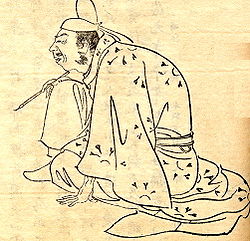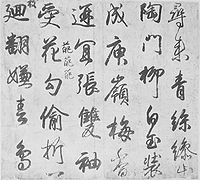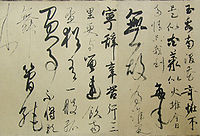
Ono no Michikaze
Encyclopedia

Heian period
The is the last division of classical Japanese history, running from 794 to 1185. The period is named after the capital city of Heian-kyō, or modern Kyōto. It is the period in Japanese history when Buddhism, Taoism and other Chinese influences were at their height...
(794–1185). One of the so-called Sanseki
Sanseki
The term Sanseki or "three [brush] traces" is used in Japanese to refer to a group of three famous Heian period calligraphers:*Ono no Michikaze, known as Yaseki from the character 野 in his name....
三跡 (Three Brush Traces), along with Fujiwara no Sukemasa and Fujiwara no Yukinari. Tōfū is considered the founder of Japan
Japan
Japan is an island nation in East Asia. Located in the Pacific Ocean, it lies to the east of the Sea of Japan, China, North Korea, South Korea and Russia, stretching from the Sea of Okhotsk in the north to the East China Sea and Taiwan in the south...
ese style calligraphy
Calligraphy
Calligraphy is a type of visual art. It is often called the art of fancy lettering . A contemporary definition of calligraphic practice is "the art of giving form to signs in an expressive, harmonious and skillful manner"...
or wayōshodō 和様書道.
Life
Michikaze was born in the present Kasugai, AichiKasugai, Aichi
is a city located in Aichi, Japan. The city was founded on June 1, 1943. As of March 1, 2010, the city had an estimated population of 303,181 and a density of . The total area is ....
prefecture, as the grandson of a courtier-poet, Ono no Takamura
Ono no Takamura
also known as was an early Heian period scholar and poet.-Life:Takamura is a descendant of Ono no Imoko who served as Kenzuishi, and his father was Ono no Minemori. He is the grandfather of Ono no Michikaze, one of the...
. He was a government official, a poet and a calligrapher. He provided highly distinguished calligraphic services for three emperors during his career: Daigo
Emperor Daigo
was the 60th emperor of Japan, according to the traditional order of succession.Daigo's reign spanned the years from 897 through 930. He is named after his place of burial.-Traditional narrative:...
(reigned from 897 to 930), Suzaku
Emperor Suzaku
was the 61st emperor of Japan, according to the traditional order of succession.Suzaku's reign spanned the years from 930 through 946.-Traditional narrative:...
(reigned from 930 to 946) and Murakami
Emperor Murakami
was the 62nd emperor of Japan, according to the traditional order of succession.Murakami's reign spanned the years from 946 to his death in 967.-Traditional narrative:...
(reigned from 946 to 967). Michikaze's fame permitted him to serve, at the age of twenty-seven, in the Seiryoden, the residential quarters of the imperial court.
As a recognition of his high skill, Emperor Daigo offered the Buddhist monk Kanken two volumes of Michikaze's works in 927, and urged him to take them with him on a voyage to China
China
Chinese civilization may refer to:* China for more general discussion of the country.* Chinese culture* Greater China, the transnational community of ethnic Chinese.* History of China* Sinosphere, the area historically affected by Chinese culture...
, and commend Michikaze’s calligraphic achievements to the Chinese.
Michikaze had lost much of his sight by the time he died.
Works


Wang Xizhi
Wang Xizhi was a Chinese calligrapher, traditionally referred to as the Sage of Calligraphy , who lived during the Jin Dynasty...
, however, he added his own refinments, that resulted in a softer feel with more freedom of movement than was common under the strictures of Chinese calligraphy.
He created the Japanese style calligraphy (wayo) that was later refined by other two masters, Fujiwara no Sukemasa
Fujiwara no Sukemasa
was a son of Fujiwara no Atsutoshi, and a renowned Japanese calligrapher of the Heian period. He is honored as one of the Sanseki, a group of outstanding calligraphers.-References:...
and Fujiwara no Yukinari
Fujiwara no Yukinari
was a Japanese calligrapher during the Heian period. He was memorialized for his prowess in his chosen art by being remembered as one of the outstanding Three Brush Traces , along with Ono no Michikaze and Fujiwara no Sukemasa.-Life:...
. Wayo was accredited and practiced, as a pure Japanese art form, until the mid-19th century.
Michikaze showed great diligence in his works, which resulted in grandiose character forms, and powerful lines. None of Michikaze's kana
Kana
Kana are the syllabic Japanese scripts, as opposed to the logographic Chinese characters known in Japan as kanji and the Roman alphabet known as rōmaji...
calligraphy are extant. A number of extant kanji
Kanji
Kanji are the adopted logographic Chinese characters hanzi that are used in the modern Japanese writing system along with hiragana , katakana , Indo Arabic numerals, and the occasional use of the Latin alphabet...
works are believed to be by Michikaze, but only a few are positively attributed. One of the well-known works ascribed without much evidence to Michikaze is a draft for an inscription on a byoubu (Japanese folding screen
Folding Screen
A folding screen , is a piece of free-standing furniture which consists of several frames or panels connected by hinges. It can be made in a variety of designs and with different kinds of materials. Screens have many practical and decorative uses...
) now mounted as a handscroll in the Tokyo Imperial Household collection. It was executed in semi-cursive script (gyosho), and consisted of ten poems by Michikaze's contemporary Oe no Asatsuna.
The collection also has his other masterpieces, like the Gyokusen-Jo handscroll, which are poems by a Tang poet. Michikaze also was attributed to many kohitsu-gire (famous calligraphic works) of the Heian
Heian period
The is the last division of classical Japanese history, running from 794 to 1185. The period is named after the capital city of Heian-kyō, or modern Kyōto. It is the period in Japanese history when Buddhism, Taoism and other Chinese influences were at their height...
era, among which a scroll containing forty-nine waka
Waka (poetry)
Waka or Yamato uta is a genre of classical Japanese verse and one of the major genres of Japanese literature...
poems from the twelfth volume - "Poems of Love" - of the early-Heian poetry anthology, Kokin Wakashū. Among his last works are eleven letters, in one of which he bemoans the evanescence of life.
Legacy
- On the 20th October 2000 (Heisei 12), an 80¥ "Willow and frog" stamp was issued in Aichi PrefectureAichi Prefectureis a prefecture of Japan located in the Chūbu region. The region of Aichi is also known as the Tōkai region. The capital is Nagoya. It is the focus of the Chūkyō Metropolitan Area.- History :...
, depicting Michikaze watching a leaping frog and a frog. - There is a shrine to his spirit in Kyoto, where his divine soul is considered to be protecting the women of the region in maternity.
- Ono no Michikaze is depicted on the "rainman" of the traditional Japanese playing cards HanafudaHanafudaare playing cards of Japanese origin that are used to play a number of games. The name literally translates as "flower cards". The name also refers to games played with those cards.-History:...
.

